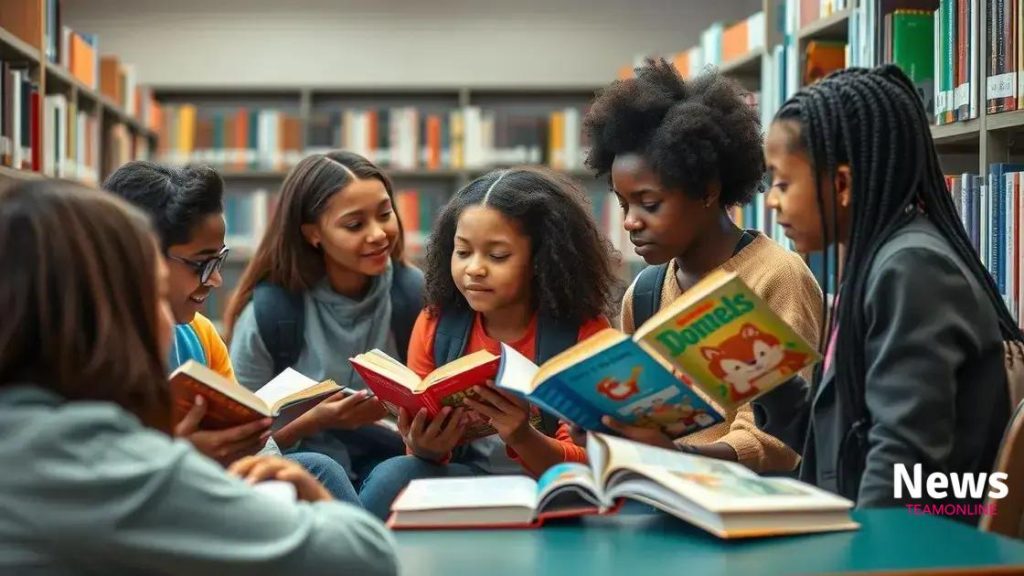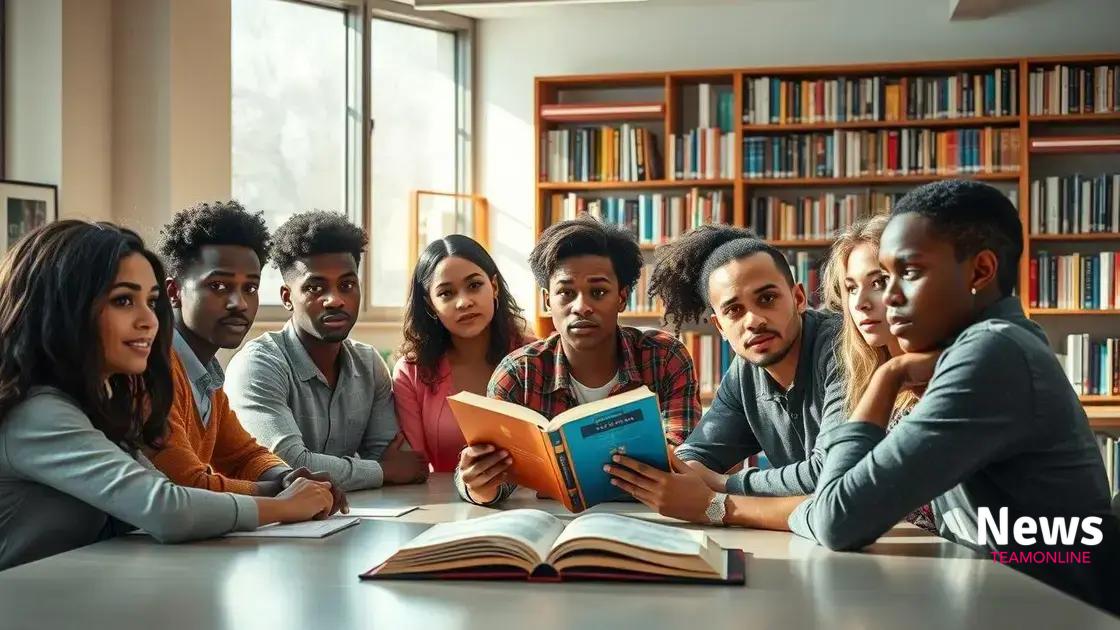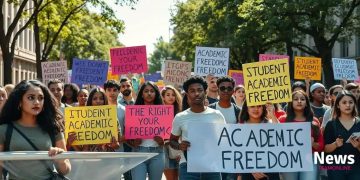School library censorship opposition: why it matters

School library censorship opposition is vital for maintaining access to diverse literature, ensuring students can engage with various perspectives and develop critical thinking skills.
School library censorship opposition is more than a trend; it’s a crucial part of safeguarding our students’ access to diverse ideas and information. Why does this matter so much? Let’s explore the implications together.
Understanding censorship in school libraries
Understanding censorship in school libraries is essential for recognizing the challenges that students face in accessing information. Censorship occurs when materials are restricted or removed from libraries, limiting students’ exposure to diverse perspectives.
Censorship can arise from various sources, including parents, school boards, and community members. Each group may have different reasons for wanting to challenge specific books or resources. Understanding the motives behind these actions allows us to consider their implications on knowledge and understanding.
Why Does Censorship Happen?
People may push for censorship due to concerns about age-appropriateness, values, or content perceived as offensive. These reasons can vary widely and reflect personal beliefs. In many cases, requests for censorship arise from:
- A fear of misinformation or harmful content.
- Religious or cultural differences influencing perspectives.
- Desire to protect students from uncomfortable or challenging topics.
This concern for students can lead to safe approaches that unintentionally limit their ability to think critically. When certain books are removed without discussion, students are deprived of understanding complex issues. This can create an environment where ideas and debates are stifled, which is counterproductive to the purpose of education.
The Impact of Censorship
Simply put, censorship in school libraries impacts students’ learning experiences. When specific books are challenged, students might feel disconnected from their academic environment. They may also miss opportunities to engage with critical themes that are relevant to their lives.
It’s crucial to remember that exposure to diverse viewpoints fosters critical thinking. By debating different ideas and opinions, students become more informed citizens. This process encourages them to consider multiple perspectives, fostering empathetic understanding and broadening their horizons.
Every challenge to books must be approached thoughtfully. School libraries should ensure that a variety of materials are available to students for them to explore and grow intellectually. Encouraging open discussions about censorship allows students to learn how to express their thoughts respectfully while understanding opposing viewpoints.
Historical context of library censorship
Historical context of library censorship reveals how the struggle for intellectual freedom has evolved over time. Understanding this background helps us appreciate why certain materials are challenged even today.
Censorship is not a new concept; it has existed in various forms throughout history. From ancient civilizations to modern times, authorities have often sought to control the flow of information. This has included banning books that challenge the status quo or that contain controversial ideas.
Key Historical Events
Several significant events have shaped the landscape of library censorship:
- The burning of books in ancient China demonstrated the extreme measures taken to suppress dissent.
- During the Inquisition, various texts were prohibited, aimed at maintaining religious orthodoxy.
- The rise of totalitarian regimes in the 20th century led to numerous censorship efforts worldwide.
Each of these instances reflects a desire to control thought and maintain societal norms. Over time, individuals and groups have fought back against these efforts, advocating for access to information and the importance of diverse perspectives.
Modern Implications
Today, the struggle continues. Despite the establishment of laws protecting free speech, challenges to library materials are still prevalent. These challenges often stem from disagreements about content related to race, sexuality, and politics. Understanding the historical context offers insight into why these discussions can be particularly heated.
By studying past censorship efforts, we can better recognize patterns and motivations in current challenges. Awareness enables educators, parents, and students to engage in informed debates about what materials should be accessible in school libraries. Knowledge of history inspires advocates to stand firm against censorship and promote intellectual freedom.
Impact of censorship on students

Impact of censorship on students can have profound effects on their education and personal development. When certain books or materials are banned or challenged, it limits students’ access to diverse thoughts and perspectives.
Students rely on school libraries to provide a wide range of resources. When censorship occurs, they miss out on exploring themes that resonate with their experiences. This absence could foster feelings of isolation and misunderstanding.
Emotional and Social Effects
Access to varied literature is vital for students’ growth. When they encounter censored materials, it can lead to:
- A sense of confusion about differing viewpoints.
- Feelings of frustration over not being able to engage in important discussions.
- Reduced empathy towards others, as they may lack exposure to diverse backgrounds.
When students face restrictions, the emotional burden can lead to disengagement from learning. They may question their own values and the motives behind censorship, which can diminish their trust in educators and the system.
Academic Consequences
The impact of censorship also extends to academic performance. Without access to critical resources, students may lack the background knowledge needed to excel in their studies. For instance, literature that addresses social issues can provide context for understanding complex subjects in history and science.
Furthermore, censorship undermines critical thinking. When students are not encouraged to analyze and critique various viewpoints, they may struggle to develop their own opinions. A well-rounded education should inspire curiosity and challenge assumptions, elements that censorship directly opposes.
By fostering a supportive environment that values intellectual freedom, schools can mitigate these negative impacts. Allowing students to engage with various texts prepares them to navigate a diverse and complex world.
Strategies to oppose library censorship
Strategies to oppose library censorship are essential for promoting intellectual freedom in schools. When communities rally around the importance of access to information, they empower students and foster a culture of learning.
Building a strong foundation against censorship requires informed and collaborative efforts. Educators, students, parents, and community members can all play a role in defending the right to read.
Education and Awareness
One effective strategy is to raise awareness about censorship issues. This can include:
- Organizing workshops or seminars that discuss the significance of free access to literature.
- Creating informational campaigns that highlight the effects of censorship on students.
- Developing partnerships with local organizations to strengthen support for intellectual freedom.
By educating the community, individuals become more adept at recognizing censorship attempts and advocating for open dialogue.
Encouraging Open Dialogue
Encouraging discussions around challenged materials fosters a mutual understanding of different viewpoints. Schools can host forums where students and parents can express their thoughts without fear of judgment. These conversations create a platform for sharing opinions and experiences related to various books.
Additionally, schools can include critical thinking skills in their curriculum, encouraging students to analyze and evaluate diverse perspectives. This approach prepares students to defend their right to access information thoughtfully.
Empowering students to express themselves is another key strategy. When they articulate their opinions, they learn to advocate for their beliefs. Student-led initiatives can be powerful, allowing learners to share their passion for diverse literature.
Involvement in Policy Making
Active participation in policy-making processes is crucial for opposing censorship. Parents and community members can attend school board meetings and advocate for clear policies that support intellectual freedom. By voicing their concerns, they help create an environment that values open access to information.
Schools should also adopt clear guidelines for handling challenges to library materials. Establishing a systematic review process ensures that each challenge is fairly evaluated. This transparency fosters trust between educators, students, and parents.
In summary, opposing library censorship involves a blend of education, open dialogue, and active participation in policy-making. When communities unite, they create a stronger defense against censorship, ensuring that students have the resources they need to learn and grow.
Case studies in successful challenges
Case studies in successful challenges provide powerful examples of how communities can stand against censorship in school libraries. These stories demonstrate the importance of advocacy and the impact of diverse voices.
Through various instances, we see how resistance to book challenges has not only preserved access to literature but has also sparked meaningful conversations in schools.
Example 1: The “Harry Potter” Controversy
In the early 2000s, several schools in the United States faced challenges against the “Harry Potter” series. Critics argued that it promoted witchcraft and was inappropriate for children. However, students and parents rallied to support the books, recognizing their value in promoting imagination and resilience.
In many cases, school boards held open meetings where students voiced their opinions. These discussions highlighted the joy and excitement the series brought to young readers. As a result, many schools decided to keep the books in their libraries, reinforcing the importance of student input.
Example 2: Challenging Racist Content
Another notable case involved the classic book “To Kill a Mockingbird.” When some parents challenged its inclusion in the curriculum due to its themes of racial injustice and language, students and teachers responded by organizing discussions and educational forums.
The focus was not only on the book itself but on the lessons it teaches about empathy and understanding. This community engagement encouraged school districts to maintain the book in their catalogs while offering supplemental materials that address the historical context and themes.
Example 3: Graphic Novels and Representation
In recent years, graphic novels like “Gender Queer” have faced challenges for their portrayal of diversity and representation. Activists for LGBTQ+ rights and students advocating for inclusive education have pushed back against these challenges.
Through petitions, community meetings, and awareness campaigns, they have effectively communicated the significance of these stories to students’ understanding of themselves and others. Many libraries have chosen to retain these graphic novels, citing the need for diverse representation in literature.
These case studies showcase how passionate advocacy can lead to successful outcomes. By standing together, communities send a clear message about the value of access to diverse literature and the importance of addressing censorship directly.
In conclusion, standing against censorship in school libraries is vital for fostering an environment of intellectual freedom. The strategies we’ve explored show that communities can play a significant role in advocating for access to diverse literature. By educating, engaging in open dialogues, and participating in policy discussions, students and adults alike can help protect the right to read. History has taught us that successful challenges to censorship encourage critical thinking, empathy, and understanding among students, preparing them for an increasingly complex world.
FAQ – Frequently Asked Questions about School Library Censorship
What is school library censorship?
School library censorship occurs when individuals or groups attempt to challenge or remove books and materials from libraries, often based on their content or themes.
Why is opposing censorship important?
Opposing censorship is crucial as it ensures students have access to diverse perspectives, promotes critical thinking, and fosters an inclusive learning environment.
How can communities support efforts against censorship?
Communities can support anti-censorship efforts by educating others, participating in discussions, and advocating for policies that protect intellectual freedom in schools.
What are some examples of successful challenges to censorship?
Successful challenges include the defense of books like “Harry Potter” and “To Kill a Mockingbird,” where community advocacy helped maintain access to these important literary works.





